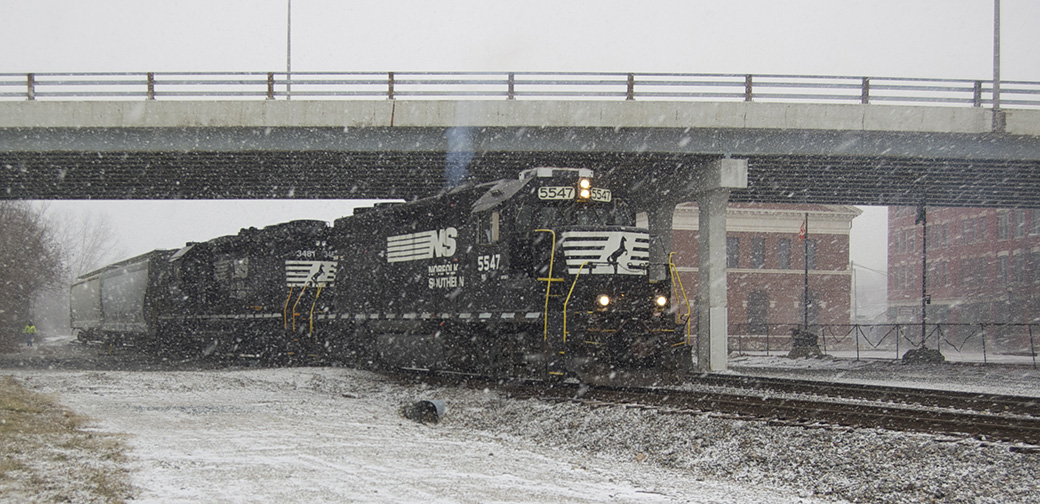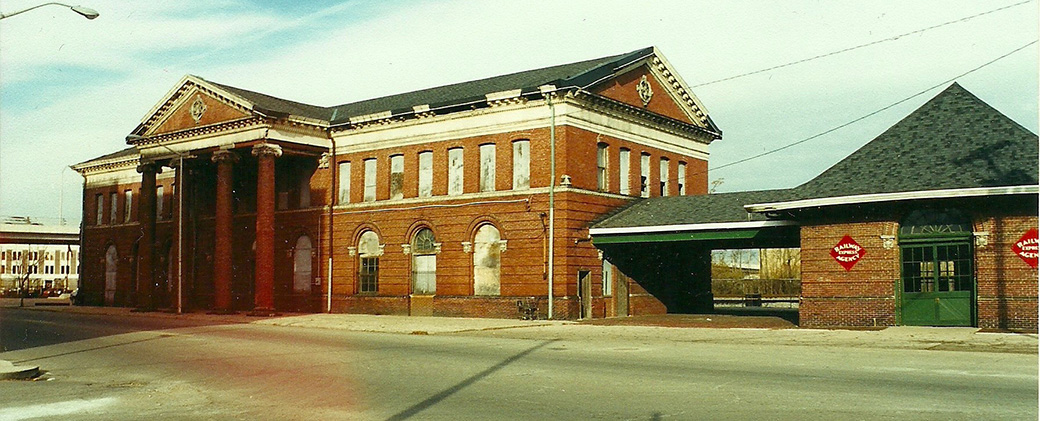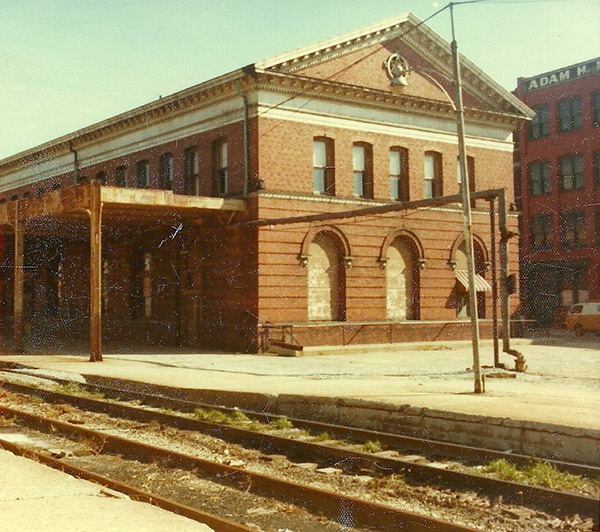
From The Heart
I have a fondness for steam radiators. That gentle heat soaks right down to the bone and although the houses I grew up in didn’t have them, the Pennsylvania depot did. From the time I was five or six years old my dad and I made a pilgrimage to the PRR depot in Richmond every Sunday morning. The waiting room was our refuge from the cold and I was never very far from one of those big radiators.
The objects of our quest were two westbound passenger trains; two of a dwindling number of passenger runs still on the Pennsy’s schedule in the 1960s. My memory is faulty where the early train is concerned, though a check of my copy of the 1960 timetable suggests it might have been No. 71, an unnamed Cincinnati to Chicago run.
Later in the morning, No. 3, the westbound Penn Texas was the prime catch. Put on the schedule in 1948, her heyday was over by the 1960s and two E-units were the regular power. She sometimes had three and on one memorable occasion, four E7s or 8s on the point, towing head-end equipment, coaches, dining and lounge cars along with several Pullmans bringing up the rear. Even though the glory days of The Standard Railroad of The World had passed, the PRR still knew how to put on a show.

By the early 2000s, the depot was suffering from decades of neglect and water infiltration. Boarded up and quickly losing her decorative trim, she was a neighborhood eyesore in the eyes of many.
Completed in 1903, the depot I remember was the third one that served the city. Designed by noted Chicago architect Daniel Burnham, it was built as part of the PRR’s westward expansion and consolidation between Pittsburgh and St. Louis.
Until the 1950s when the highway overpass was built, there was a large iron train shed that covered the tracks. All that was left of that in my time was the extension that covered the platform on the north side of the building. Eventually, even that was removed and the building sat derelict and decaying for decades. It was finally sold to a local businessman, who raised capitol and secured a matching grant to do a proper restoration inside and out. Thankfully, the historic structure has a new lease on life and a bright future.

This tired photo from the 1970s shows the west end of the depot. All the station trackage is still in place along with the concrete platforms. My favorite train spotting perch for the Penn Texas was the platform in the extreme lower left foreground. Today, all of the tracks are gone except the NS mainline and remnants of the freight bypass tracks, that form the present day yard where crews sort out cars for Primax Plastics. As seen in the title photo, a chain link fence separates the tracks from people.
It was a far different world in the 1960s. In Richmond you could use the crosswalks and go out on the platforms without restriction and my favorite vantage point (under dad’s ever watchful eye) was the center platform where I could look to the east down Track One for a headlight coming around the distant curve by Glen Yards. Once spotted, I would retreat back to the safety of the canopy next to the station while the train glided in and eased to a stop.
A flurry of activity had already commenced. The engines would stop short of the five-way crossing at Eighth Street for refueling. There were a number standpipes on the platform and a fuel tender would dutifully appear to top off the units. Baggage handlers would already be exchanging any baggage or mail. Passengers would disembark or board as needed and soon, the boss would give two tweets to the cab that he was ready to roll. With the engineer’s get-out-of-the-way twin blasts from the air horn, the crossing watchman would lower the gates at Eighth Street as she eased out of the station, around the curve next to Newman Tower and Purina and then out of sight. It was a cold weather spectacle with steam coming from every leaky joint in the consist.
There was a lull between trains and we would often head down to the bridge at Nineteenth Street over the west entrance to Glen Yards. Nothing much ever happened there on a Sunday and any action we did catch was icing on the cake. Sometimes a yard engine would be shuffling around or there might be a flurry of activity near the turntable. One never knew.
After we moved to Spruce Street in Centerville, The double tracked Columbus Division main line and long siding next to the house became the stage for the daily play the PRR put on. Year in and year out I watched it all, getting to know some of the regular crew and snagging at least one cab ride up and down the siding. The sights, sounds and wonderful innocence of it all are as fresh as if it happened yesterday.
Memories of times with my dad along with the sights and sounds of the railroad are the foundation of my interest in model trains. For a introverted and geeky teenager, the craft provided a safe refuge during the late sixties and early seventies, years that proved a turbulent time for our country.
The first layouts, if you want to use that term, were American Flyer tinplate. HO followed and held sway until the recent switch to P48. As a child, my parents never begrudged my hobby activities. With the cultural upheavals of that era, mom always knew where I was and what I was doing; generally up in our finished attic working on a never-ending series of layouts that were never even close to completion.
It’s the time of year when people will be introduced to model trains perhaps for the first time. Would our narrative sound more compelling, if we dropped the sales pitch and shared more from the heart about what trains mean to us? I believe it would. What about you?
Regards,
Mike
The hobby would benefit from more writing that so beautifully frames our individual relationship with trains.
It’s only natural that as we grow, our current interests should evolve but the substance of the initial attraction should remain as a constant running through everything we do. Like a friendship, what you need from the friendship changes but what remains is the bond forged by your shared history and that is made more resilient by time.
We are skilled in the art of communicating technique and the theory that we use to create the models. We will always need to help the learner learn how to manage the tools of the craft but he already comes equipped as an expert in why he’s here at all. Not guidance on where to find a story but more exposure to variations on the hobby so that within the greater realm of model railways the modeller can see other options for how to express his vision in the media that is model trains; instead of just more three dimensional photographs. But I’m digressing from something you created that was just perfect and beautiful.
/chris
Hi Chris,
One of the many reasons I like David P. Morgan’s writing so much is that he painted a word picture I can relate to, even decades removed. He gives readers the nuts and bolts details they crave like engine numbers and class but always gift wraps these nuggets in a rich narrative that provided a context that draws you into his experience trackside. You’re quite correct, we hand people the tools but give them little idea what they can do with them beyond simple copying.
Regards,
Mike
Hi Mike,
I like the way you opened with the emotional memory: the radiator. I know exactly what you’re talking about and instantly we have a shared experience. We’re connected and placing that at the head of the story lays a strong foundation. The story radiates out from those warm radiators and we have that common point to continue to return to if ever we drift apart. When we get to something that’s different, we still have that something in common to return to, to encourage us to find details that we could still relate to. We invest in that relationship with the work and in turn with each other such as: I don’t know that particular station’s waiting room but I know one like it and that becomes the second point we have in common.
You could have just jumped right into the story of the station’s transition over time. A story of decay and rebirth. A story of growing older. You could have done so and hoped that I had something in common from my past. Something that was equally relevant and familiar to both of us that we could then move forward with. What if I didn’t? What a waste to have to keep attempting to spark a bond and with every subsequent sentence, possibly revisiting that risk and only further defining all the ways that we’re different. Even if we had so much in common, we’d just keep moving apart in terms of appreciating the work. This, I believe, is how we present our work in this hobby.
I think it’s that contrast in presenting the narrative of our work that we’re only starting to appreciate the value of. I’ve rambled on before about my frustration with insisting that knowing my prototype, my era, my style is more important than looking for something we have in common. As if knowing the steam ear in Los Angeles is really more important that appreciating the work I’ve created, while attempting to model my interpretation of that. I believe that the modeler wants to present his best work in the way any true Craftsman would insist on. That work comes with time and I see evidence of that in the way we seem to constantly be creating new masters in this hobby.
This is one of those posts I’ll hang on to for as long as I can. It’s beautiful and I’m so glad you shared it with us.
Chris
Thanks for the kind words Chris.
Your point about knowing a similar waiting room is one we tend to overlook. It’s impossible to totally share the same experience even if one is present. We each take away something unique to us. That one can share a memory that invites others to reflect on their own is not easy to do. You have to step out of the way, so others have room to explore. Our craft tends to homogenize things, even though we each use the tools differently. The narratives we use clone themselves because we think that’s what people want.
Regards,
Mike